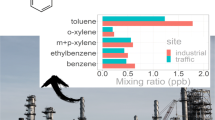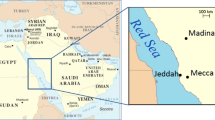Abstract
A preliminary study has been taken up to evaluate the NHHCs concentration and their effect on atmospheric chemistry at Bhubaneswar for the very first time during winter months when pollution load is prevalent. For this purpose ambient air samples were collected during a period of 3 months (Dec 2013–Feb 2014). The samples were analyzed for C2–C5 light non-methane hydrocarbons (NMHCs) using a gas chromatograph with a thermal desorption system. It was observed that level of NMHCs over the measurement site was lower in comparison to other urban locations within India but higher in comparison to Bay of Bengal. Statistical interpretation suggests a non-significant variation of NMHCs concentration between the observation months. Diurnal observations revealed a higher concentration of both n-pentane and i-pentane which was mostly attributed to solvent evaporation. Liquefied petroleum gas usage is believed to be a major contributor to the mixing ratios of propane (1.5 ppbv) and butane (0.027 ppbv) while ethane and ethylene emissions were attributed to traffic volume and vehicular exhausts. The propylene-equivalent and ozone formation potential of NMHCs have also been calculated in order to find out their OH reactivity and contribution to the photochemical ozone formation. Relative humidity was also observed to have a significant correlation with NMHCs concentration. Variation of total non-methane hydrocarbons (TNMHCs) with ozone and CO suggest the role of TNMHC as precursor for ozone formation.






Similar content being viewed by others
References
B.R. Gurjar, J.A. van Aardenne, J. Lelieveld and M. Mohan, Emission estimates and trends (1990–2000) for megacity Delhi and implications, Atmos. Environ., 38 (2004) 5663–5681.
R. Sindhwani and P. Goyal, Assessment of traffic–generated gaseous and particulate matter emissions and trends over Delhi (2000–2010), Atmos. Pollut. Res., 5 (2014) 438–446.
D. Vione, V. Maurino, C. Minero, E.Pelizzetti, M.A.J. Harrison, R.I. Olariu and C. Arsene, Photochemical reactions in the tropospheric aqueous phase and on particulate matter, Chem. Soc. Rev., 35 (2006) 441–453. doi:10.1039/b510796m.
T.P. Singh, Study of volatile organic compounds (VOCs), trace gases (ozone and NOx) and black carbon at Dayalbagh: a semi-urban site. Ph.D. Thesis Dayalbagh educational institute (Deemed university) (2012).
R. Atkinson, Atmospheric chemistry of VOCs and NO x , Atmos. Environ., 34 (2000) 2063–2101.
C. Varotsos, J. Christodoulakis, C. Tzanis and A.P. Cracknell, Signature of tropospheric ozone and nitrogen dioxide from space: a case study for Athens, Greece., Atmos. Environ., 89 (2014) 721–730.
C. Tzanis, C. Varotsos, J. Christodoulakis, J. Tidblad, M. Ferm, A. Ionescu, R.A. Lefevre, K. Theodorakopoulou and K. Kreislova, On the corrosion and soiling effects on materials by air pollution in Athens, Greece, Atmos. Chem. Phys., 11 (2011) 12039–12048.
C. Varotsos, M. Efstathiou, C. Tzanis and D. Deligiorgi, On the limits of the air pollution predictability: the case of the surface ozone at Athens, Greece, Environ. Sci. Pollut. Res., 19 (2012) 295–300.
K. Saarnio, M. Sillanpaa, R. Hillamo, E. Sandell, A.S. Pennanen and R.O. Salonen, Polycyclic aromatic hydrocarbons in size-segregated particulate matter from six urban sites in Europe, Atmos. Environ., 42 (2008) 9087–9097.
C. Varotsos, J. Ondov, C. Tzanis, F. Ozturk, M. Nelson, H. Ke and J. Christodoulakis, An observational study of the atmospheric ultra-fine particle dynamics, Atmos. Environ., 59 (2012) 312–319.
A. Rao et al., Non-methane hydrocarbons in industrial locations of Bombay, Atmos. Environ., 31(1997) 1077–1085.
L.K. Sahu and S. Lal, Distributions of C2–C5 NMHCs and related trace gases at a tropical urban site in India, Atmos. Environ., 40 (2006) 880–891.
L.K. Sahu and S. Lal, Characterization of C2–C4 NMHCs distributions at a high altitude tropical site in India, J. Atmos. Chem., 54 (2006) 161–175.
S. Lal, L.K. Sahu, S. Venkataramani, T.A. Rajesh and K.S. Modh, Distributions of OZONE, CO and NMHCs over the rural sitesin central India, J. Atmos. Chem., 61 (2008) 73–84.
M. Naja, S. Lal and D. Chand, Diurnal and seasonal variabilities in surface ozone at a high altitude site Mt Abu (24.6°N, 72.7°E, 1680 m asl) in India, Atmos. Environ., 37 (2003) 4205–4215.
Y.V. Swamy, R. Venkanna, G.N. Nikhi, D.N.S.K. Chitanya, P.R. Sinha, M. Ramakrishna and A.G. Rao, Impact of nitrogen oxides, volatile organic compounds and black carbon on atmospheric ozone levels at a semi arid urban site in Hyderabad, Aerosol Air Qual. Res. 12 (2012) 662–671.
C. Mallik, S. Lal, S. Venkataramani, M. Naja and N. Ojha, Variability in ozone and its precursors over the Bay of Bengal during post monsoon: transport and emission effects, J. Geophys. Res., 118 (2013) 10–190.
C.Mallik, D.Ghosh, D.Ghosh, U. Sarkar, S. Lal and S. Venkataramani, Variability of SO2, CO, and light hydrocarbons over a megacity in eastern India: effects of emissions and transport, Environ. Sci. Pollut. Res., 21 (2014) 8692–8706. doi:10.1007/s11356-014-2795-x.
B. Barletta, S.Meinardi, F.S. Rowland, C.Y. Chan, X.C. Wang, L.Y. Chan and D.R. Blake, Volatile organic compounds in 43 Chinese cities, Atmos. Environ., 39 (2005) 5979–5990.
R. Koppmann, F.J. Johnen, A. Khedim, J. Rudolph, A. Wedel and B. Wiards, The influence of ozone on light nonmethane hydrocarbons during cryogenic preconcentration, J. Geophys. Res., 100 (1995) 11383–11391.
N. Poisson, M. Kanakidou and P.J. Crutzen, Impact of non-methane hydrocarbons on tropospheric chemistry and the oxidizing power of the global troposphere: 3-dimensional modelling results, J. Atmos. Chem., 36 (2000) 157–230.
T. Berntsen, I.S.A. Isaksen, W.C. Wang and X.Z. Liang, Impacts of increased anthropogenic emissions in Asia ontropospheric ozone and climate. A global 3D model study, Tellus, 48B (1996) 13–32.
P.J. Crutzen, Ozone in the troposphere, in: Singh, H.B. (Ed.), Composition, chemistry, and climate of the atmosphere, Van Nostrand Reinhold, New York (1995) pp. 349–393.
P.S. Mahapatra, S. Panda, N. Das, S. Rath and T. Das, Variation in black carbon mass concentration over an urban site in the eastern coastal plains of the Indian sub-continent, Theor. Appl. Climatol., 117 (2013) 133–147. doi:10.1007/s00704-013-0984-z.
P.S. Mahapatra, S. Panda, P.P. Walvekar, R. Kumar, T. Das and B.R. Gurjar, Seasonal trends, meteorological impacts, and associated health risks with atmospheric concentrations of gaseous pollutants at an Indian coastal city, Environ. Sci. Pollut. Res., 21 (2014), 11418–11432.
S. Verma, S.K. Pani and S.N. Bhanja, Sources and radiative effects of wintertime black carbon aerosols in an urban atmosphere in east India, Chemosphere, 90 (2013) 260–269.
S. Lal, L.K. Sahu, S. Venkataramani and C. Mallik, Light non-methane hydrocarbons at two sites in the Indo-Gangetic Plain, J. Environ. Monit., 14 (2012) 1159.
S.P. Gupta Statistical method. Sultan Chand and Sons, New Delhi (2005).
A.N. Johnson, C.J. Crowley and T.T. Yeh, Uncertainty analysis of NIST’s 20 liter hydrocarbon liquid flow standard, MAPAN-J. Metrol. Soc India, 26 (2011) 187–202.
C.H. Li and A. Johnson, Bilateral comparison between NIM’s and NIST’s gas flow standards, MAPAN-J. Metrol. Soc India, 26 (2011) 211–224.
M. Carter, W. Johansen and C. Britton, Performance of a gas flow meter calibration system utilizing critical flow venturi standards, MAPAN-J. Metrol. Soc India, 26 (2011) 247–254.
T. Salameh, C. Afif, S. Sauvage, A. Borbon and N. Locoge, Speciation of non-methane hydrocarbons from anthropogenic sources in Beirut, Lebanon, Environ. Sci. Pollut. Res., 21 (2014) 10867–10877. doi:10.1007/s11356-014-2978-5.
J.H. Tang, L.Y. Chan, C.Y. Chan, Y.S. Li, C.C. Chang, S.C. Liu, D. Wu and Y.D. Li, Characteristics and diurnal variations of NMHCs at urban, suburban and rural sites in Pearl River Delta and a remote site in south China, Atmos. Environ., 41 (2007) 8620–8632.
D.R. Blake and F.S. Rowland, Urban leakage of liquefied petroleum gas and its impact on Mexico City, Air Qual. Sci., 269 (1995) 953–956.
S. Saito, I. Nagao and H. Kanzawa, Characteristics of ambient C2–C11 non-methane hydrocarbons in metropolitian Nagoya, Japan, Atmos. Environ., 43 (2009) 4384–4395.
J.H. Tang, S.J. Guo, Y.L. Ma, F.M. Yang, K.B. He, Y.C. Yu, J.W. Wang, Z.B. Shi and G.C. Chen, Non-methane hydrocarbons and their ozone formation potentials in Foshan, China, Aerosol Air Qual. Res., 12 (2012) 387–398.
R. Friedrich and A. Obermeir, Anthropogenic emissions of volatile organic compounds, in: Hewitt, C.N. (Ed.), Reactive hydrocarbons in the atmosphere. Academic Press, San Diego (1999) pp. 1–39.
W.L. Chameides, F. Fehsenfeld, M.O. Rodgers, C. Cardelino, J. Martinez, D. Parrish, W. Lonneman, D.R. Lawson, R.A. Rasmussen, P. Zimmerman, J. Greenberg, P. Middleton and T. Wang, Ozone precursor relationships in the ambient atmosphere, J. Geophys. Res., 97 (1992) 6037–6055.
W.P.L. Carter, Development of ozone reactivity scales for volatile organic compounds, J. Air Waste Manag. Assoc., 44 (1994) 881–899.
W.P.L. Carter, Maximum incremental reactivity excel spreadsheet (1997). http://pah.cert.ucr.edu/carter/rcttab.htm.
B. Güttler and W. Richter, Metrology in chemistry in Germany, MAPAN-J. Metrol. Soc India, 25 (2010) 219–225.
K.L. Johnson, L.H. Dworetsky and A. N. Heller, Carbon monoxide and air pollution from automobile emissions in New York City, Science, 160 (1968) 6768.
J. Lelieveld, V. Peters, F.J. Dentener and M. Krol, Stability of tropospheric hydroxyl chemistry, J. Geophys. Res., 107 (2002) 4715.
U.K. Sharma, Y. Kajji and H. Akimoto, Seasonal variation of C2–C5 NMHCs at Happo, a remort site in Japan, Atmos. Environ., 34 (2000) 4447–4458.
L. Li and X. Wang, Seasonal and diurnal variations of atmospheric non-methane hydrocarbons in Guangzhou, China, Int. J. Environ. Res. Public Health, 9 (2012) 1859–1873.
Acknowledgments
The authors would like to thank the Director, Institute of Minerals and Materials Technology (CSIR-IMMT) and the Head, Environment and Sustainability Department (CSIR-IMMT) for their encouragement. Financial support by ISRO (GBP)-ATCTM is gratefully acknowledged. The authors are also grateful to the editor of this journal as well as to both the anonymous reviewers for their valuable suggestions to improve the manuscript.
Author information
Authors and Affiliations
Corresponding author
Rights and permissions
About this article
Cite this article
Panda, U., Mahapatra, P.S. & Das, T. Study of C2–C5 Non-methane Hydrocarbons and Their Ozone Formation Potential at Bhubaneswar, an Eastern Coastal Site in India. MAPAN 30, 195–202 (2015). https://doi.org/10.1007/s12647-015-0134-4
Received:
Accepted:
Published:
Issue Date:
DOI: https://doi.org/10.1007/s12647-015-0134-4




